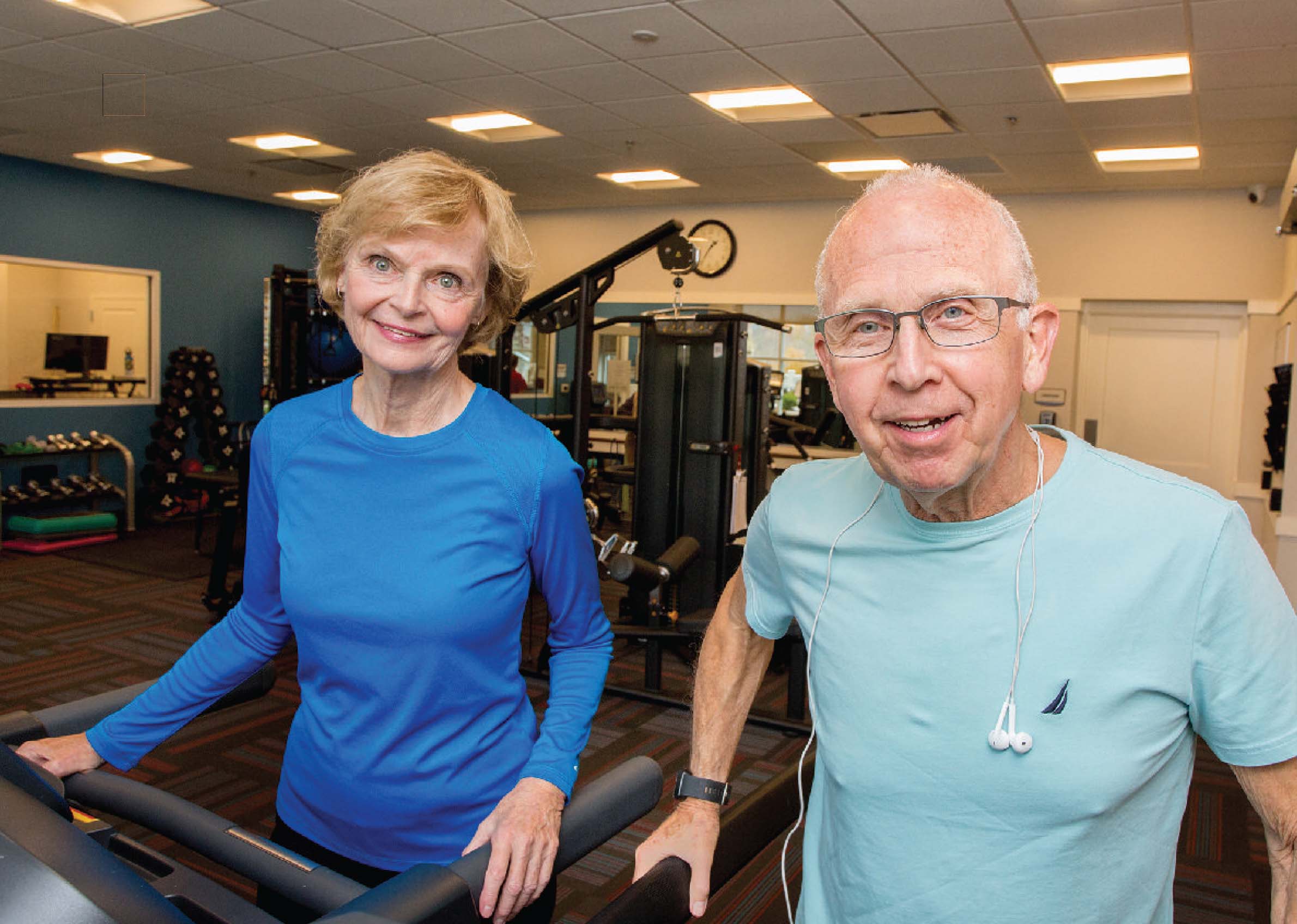Is a CCRC Right for You?
Continuing-care retirement communities (CCRCs) provide a range of amenities and health care when you need it—at a hefty cost.


Touring the grounds of Pine Run Retirement Community, in Doylestown, Pa., it’s easy to see the appeal of this continuing-care retirement community (CCRC) to its 450 or so residents.
Opened in 2019, Pine Run’s $13 million community center feels airy and modern. It’s a one-stop shop where residents can enjoy a meal in a fine-dining room or casual café, grab a drink at the bar, work out at the fitness center, swim laps in the pool, catch a lecture or movie at the auditorium, or visit the library, sundry store or salon.
Elsewhere on the 43-acre campus, villagers can tend to plants at a greenhouse, tap into their creative side at the craft barn or stroll on a walking path safe from traffic. Villagers can sign up for day trips to area events and attractions and choose among more than 50 committees, clubs and special-interest groups to join, ranging from a bird-watching club to a group that creates programming for an in-house TV channel.
From just $107.88 $24.99 for Kiplinger Personal Finance
Become a smarter, better informed investor. Subscribe from just $107.88 $24.99, plus get up to 4 Special Issues

Sign up for Kiplinger’s Free Newsletters
Profit and prosper with the best of expert advice on investing, taxes, retirement, personal finance and more - straight to your e-mail.
Profit and prosper with the best of expert advice - straight to your e-mail.
Like Pine Run, most continuing-care retirement communities strive to deliver a vibrant, active culture for residents. But the core mission of a CCRC — also known as a life-plan community — is to provide a setting where retirees can shift from independent living to higher levels of care as they age.
When you’re still able to live independently, you may choose a stand-alone home or apartment, depending on the CCRC’s offerings.
Typically, a CCRC also has assisted living for those who need some help with daily activities, a skilled-nursing facility — whether for short-term needs, such as recovering from an illness or surgery, or for long-term care for chronic conditions — and a memory-care unit for those who have dementia.

Steve and Carol Hirt of Pine Run Retirement Community.
In 2019, Steve and Carol Hirt moved into a newly constructed, 1,600-square-foot, 2.5-bedroom cottage at Pine Run, and they were able to request some modifications to the layout as it was being built.
Steve, 77, plays water volleyball and billiards with resident groups at Pine Run, volunteers at the local hospital’s heart institute and, using experience from his career in capital-campaign fund-raising, is president of a foundation that helps villagers cover living expenses if they exhaust their resources.
Carol, 77, is in a yoga group, does sewing projects at the hospital’s pediatric unit and is co-chairing a bake sale for a fall festival at Pine Run.
The Hirts like that Pine Run is operated by the Doylestown Health system of medical facilities, including the hospital. “We’re very happy we did it,” Carol says of moving to Pine Run.
An eye-catching campus, abundant amenities and the promise of a thriving social life may draw you to the front door of a CCRC. But figuring out whether such a community is right for you and selecting one that is a good fit and in solid standing are decisions that will have a big impact on your finances and health, likely for the rest of your life.
The appeal of a CCRC
For many retirees who choose to live in a CCRC, a driving factor is peace of mind that they’ll have adequate care for their future needs. That holds true for the Hirts.
“My major feeling when I got into Pine Run was relief,” says Carol. The Hirts’ two children live several hours away with busy lives of their own, and the Hirts don’t want to lean heavily on them as they age. “It lifts a load. You can really see and hear it from both of them,” says Steve.
Allison Dolan, 67, became interested in CCRCs after her own parents lived in one. “It was very reassuring to have them in a place where there was on-site attention and oversight,” she says, and she didn’t have to worry about unexpected costs for their care.
In 2017, she and her husband moved to Brooksby Village, a CCRC in Peabody, Mass. They went to Brooksby earlier than expected because her husband had Parkinson’s disease, and Brooksby offered a range of health care services on-site. When he passed away a few years ago,
Dolan benefited from being settled into the community and its many activities. Today, she leads support groups at Brooksby for Parkinson’s disease as well as weight loss, she is involved in three craft groups, and she helps manage the gardening club.
“Studies have shown that social isolation is one of the biggest health risks for older people,” she says. “There is far more socialization here than I would ever have had if I had remained in my house.”
Dolan also appreciates the general ease that comes with living in a CCRC. She doesn’t have to worry about home maintenance — if a light bulb burns out or her fridge breaks down, a fix is a call away.
Residents who no longer drive can take shuttles to local grocery stores, malls and other locations. If you don’t want to cook much, you can use the meal plan at the CCRC’s several dining venues.
Overall, the outlook for CCRCs appears mostly stable. Most growth in the industry is through expansion of existing communities, especially housing for independent living, says Lisa McCracken, director of senior-living research for investment bank Ziegler.
As CCRCs modernize their offerings to adapt to the needs and desires of new generations, they’re investing in wellness centers, providing a range of dining options and diversifying living choices for residents, from studio apartments to 4,000-square-foot homes, says McCracken.
The downsides of CCRC (one is cost)
CCRCs aren’t for everyone. The financial commitment is significant: You’ll usually have to pay a large up-front entrance fee, which may be as much as a home purchase, plus a monthly fee (more on the financial commitment below).
If you don’t like living with restrictions on how you can manage and decorate your home, you may be unhappy in a CCRC.
For example, Dolan says that some residents of her community have found it annoying that they can’t decorate the railing of their apartment’s balcony.
Usually, residents have limited control over the community’s direction and limited say in major decisions, and they may have to advocate for their contractual rights.
Jim Haynes, 85, president of the National Continuing Care Residents Association (NaCCRA), lived in a CCRC at which residents are not permitted to attend board meetings, although they can participate in a residents’ council.
About a year after he had moved into a cottage, he found out the board had decided to tear it down in favor of putting up apartment buildings. He and some of his neighbors, however, found a clause in their contracts that stated residents who are in good standing may stay at their address, and his cottage was saved.
Still, “that left a bitter taste in my mouth,” says Haynes, and he wondered whether the CCRC might renege on other commitments, too.
Many states regulate CCRCs financially to some degree, but some states don’t. And among the ones that have regulations, the scope and stringency vary.
Often, the state insurance department oversees regulation, and it may require CCRCs to disclose annual reports of their finances. You may be able to learn more about the regulation and licensure of CCRCs in your state from its long-term-care ombudsman program. Find contact information for each state’s ombudsman at www.theconsumervoice.org/get_help.
And before you move into a CCRC, you should review its financial strength; see the end of this article for tips on how to do that.
Finding the right fit
Touring CCRCs as a prospective resident is often likened to the experience of a high schooler visiting college campuses. “Each community has a distinct personality and feel,” says Jennifer Doone, senior director of sales and marketing at Pine Run Retirement Community.
“Make the investment of time to go look at communities.” Do you prefer a large, sprawling community or one with a more intimate feel? An urban setting or a rural retreat? A high-rise apartment or a stand-alone home? You may be able to arrange an overnight stay at a CCRC to get a better sense of what it’s like to live there.
Think about where you want to spend the rest of your life geographically, too — especially as you get older and traveling becomes more difficult.
Haynes, the NaCCRA president, recently moved out of his CCRC in Virginia to be closer to his grandchildren in North Carolina.
Yvonne and Ronald Crouch, ages 67 and 76, recently sold their home in southern New Jersey and moved to a CCRC in Gaithersburg, Md., that is about a half-hour drive from their granddaughter and her parents.
“We’ll be able to have them over for a meal on a Sunday or pick up our granddaughter after school if her parents can’t do that,” says Yvonne.
The Crouches also like their chosen CCRC, Asbury Methodist Village, for its green, tree-filled campus and opportunities for residents to volunteer with local churches and the surrounding community.
Try a few meals to get a taste of the food’s quality, and spend time with residents to get their perspective. The CCRC may set you up with host residents who highlight the positives, but it’s worthwhile to talk to other community members, too.
“Meet the people who are the movers and shakers to tell you about the issues of the day,” says Katherine Pearson, a professor of law at Penn State Dickinson Law who focuses on laws and policies connected to aging.
Consider all levels of care
Don’t skip the crucial step of evaluating and touring a CCRC’s accommodations for residents who need higher levels of care.
“It’s amazing how many people never want to ask those questions,” says Tripp Higgins, president of MyLifeSite, a website that provides information on CCRCs. “They feel that if they do, it’s creating a predisposition of needing the care.”
You can look up Medicare ratings for a CCRC’s care facilities by going to www.medicare.gov and clicking on “Find Providers Near Me.”

Bart and Carolyn Gohmann live at Goodwin House Alexandria, a CCRC in Alexandria, Va.
Bart and Carolyn Gohmann, ages 78 and 73, moved into independent living at Goodwin House Alexandria, in Alexandria, Va., earlier this year.
As they visited various CCRCs to narrow down their selection, they asked to tour the assisted living, skilled nursing and other care facilities before seeing anything else.
“That surprised several places,” says Carolyn. “If you wait until the end of the tour, you’re tired.” In their search, they also took note of whether communities they considered were accredited by CARF International, which reviews CCRCs for quality in several areas, including care processes and programs. See a list of CARF-accredited CCRCs at www.carf.org/ccrclisting.aspx.
Find out how care is provided and structured. Does the CCRC employ its own skilled-nursing staff, or does it contract it out? Are rehab and medical services offered on-site, or do you have to leave the campus? Can you receive in-home care while in independent living?
You may, for example, be able to hire a companion to help at your home for temporary needs, such as recovering from surgery. If you’re moving in with a spouse, ask what happens if one of you needs a different level of care than the other. Will you move together to an assisted-living or long-term-care facility, even if one spouse is able to live independently?
Ask whether plans are in the works to change the scope of care services. Communities faced with regulatory and financial pressures are looking more closely at “right sizing” their long-term-care and skilled-nursing components, says Jed Johnson, managing director of aging services for CARF.
One CCRC that Yvonne Crouch encountered in her search said that it was downsizing its nursing facility because Medicare is covering less for rehabilitation services.
How the CCRC handles the decision for residents to move from one level of care to another is an important question.
Generally, CCRCs have the exclusive right or a shared right to transfer you between levels of care, even if you disagree, says Pearson. “I see a number of heartaches come about because the resident or the resident’s family are not happy with the decision that the resident needs to go to a higher level of care,” says Pearson.
Making the numbers work
In the second quarter of 2022, the average entrance fee for a CCRC was $414,722, a 3.3% increase from a year earlier, according to the National Investment Center for Seniors Housing & Care (NIC).
You’ll also pay a monthly fee that covers amenities and services, which may include housekeeping, maintenance, utilities, fitness facilities, a meal plan, social activities and events, and other services. For those in independent living, the fee runs an average $3,774, according to the NIC.
The amounts of the entrance and monthly fees depend in part on the type of contract you have. With a Type A contract, also known as a life-care agreement, you generally pay a higher entrance and monthly fee, but your expenses shouldn’t rise beyond standard inflationary increases if you switch to higher levels of care.
Essentially, life-care agreements act as insurance for residents against steep hikes in health care costs, shifting more of that risk to the CCRC.
Life-care agreements were once the standard model, but other contract types are more common now. With a Type C (fee-for-service) contract, entrance fees are typically lower, and monthly fees may be less than you’d pay with a Type A agreement. But Type C fees do not include health services, so if you need care later, you’ll pay market rates for it.
Other agreements, including modified or Type B contracts, combine features of types A and C, providing discounts on health care to some degree. Type D contracts are rental agreements and may have no entrance fee.
A community may offer a single type of agreement or let you select among various options.
Consider a refundable fee
Drill down into how the entrance fee works. Some CCRCs offer refundable entrance fees. Such fees may be higher than nonrefundable fees, but at least a portion of the money will go back to you if you move out or back to your estate when you pass away.
“I probably get the most questions from both prospective and current residents about refundable fees,” says Pearson. “There are often charges against that refund that are not easy to detect,” such as for refurbishment of the unit after you leave.
The refund may be full or partial, or it may be amortized, with the amount you get back declining over time. Check for other limitations, too. In some cases, the fee may be paid only if the unit that you vacated is refilled.
“I end up hearing from people who have waited months and sometimes years for the refundable fee to be paid,” says Pearson.
Find out what is included in the monthly fee and what isn’t. It may, for example, include utilities such as electric and water services but not pay for high-speed internet or a phone line.
CCRCs typically raise the monthly rate each year, and lately, pressures from inflation and increased staff wages are pushing up fees at a higher rate.
A March 2022 Ziegler survey of CCRCs found that they had raised monthly fees for independent living by a median of 4%, a substantial rise from the 3% median increase each year going back more than a decade. Some facilities have raised fees 5% or more.
Ask the CCRCs you’re considering for a history of fee increases over the past 24 months and for a projection of future hikes, says Pearson.
Before you sign a contract, it’s helpful to run it by an elder-law attorney who has experience with CCRCs.
“Take those forms home with you and take time to look at them. Do not sign them the first time you see them at the facility,” says Pearson.
Selling a home to pay for a CCRC
When you apply to live at a CCRC, it should do a thorough review of your finances to help ensure that you can cover the entrance and monthly fees with a comfortable amount of income left over for other expenses, such as additional health care costs, vacations, gas and maintenance for a car, and gifts.
You’ll likely be asked to share information on your assets and liabilities, sources of monthly income and insurance policies, including supporting documents. Residents commonly use proceeds from the sale of their home to pay the entrance fee, so your current home’s value is a key factor.
CCRCs may also want to see tax returns going back a few years. It’s a good idea to have your financial adviser run an assessment, too.
The Gohmanns, who recently moved into Goodwin House Alexandria, were able to quickly sell their properties thanks to the hot housing market. The proceeds more than covered their $488,000 entrance fee.
They have a life-care (Type A) contract, and they pay the $7,400 monthly fee along with their other ongoing expenses through pension and Social Security payments — which both benefit from inflation adjustments—and dividend and interest income from their investments. They also have an emergency savings account as a cushion.
If you have a fee-for-service contract, you may face significantly higher expenses for care in the future. Pine Run Retirement Community operates on a fee-for-service model, and the Hirts pay a $5,800 monthly fee for independent living.
In case they need care at some point, they have a long-term-care insurance policy, which helps cover expenses for assistance if they can no longer perform certain activities of daily living, such as bathing, dressing and eating, on their own.
Most CCRCs are nonprofit institutions, and some have benevolent funds to help residents who can no longer afford the expenses.
To be eligible, residents typically must have managed their finances responsibly — you’d likely be turned away if the CCRC feels that you’ve squandered your money — and there’s no guarantee that adequate funds will be available, even if you qualify.
There’s no time like right now
A sentiment echoed by CCRC providers, experts and residents alike: Don’t wait too long to make the move into a CCRC. Ideally, you’ll tour communities and settle on your favorite well before you need daily care, giving you time to fully enjoy the range of amenities and features while you’re healthy.
Before you move in, you’ll undergo a health evaluation to determine whether you are eligible for independent living.
Ziegler’s McCracken, who has visited hundreds of CCRCs, says, “If I had a dollar for everyone who said ‘I wish I would have done this sooner,’ I would have retired by now myself.”
Plus, it’s not uncommon to wait a few years for a living space to become available, especially if you want one of the most desirable accommodations (larger units tend to be popular). You may be able to move into a temporary home and then switch to the one you want later or join a priority waitlist by making a deposit.
For example, Goodwin House Alexandria, where the Gohmanns reside, requires a $1,000 refundable deposit to get on its Priority Club list.
How to check a CCRC’s financials
A CCRC will take a close look at your financial situation before accepting you as a resident, and you should apply the same due diligence to the CCRC.
If a CCRC goes bankrupt, residents may fall into the category of unsecured creditors, putting them at risk of losing out on reimbursement of their entrance fees.
Ask the CCRCs you’re considering for the following information and documents. A financial adviser, such as an accountant, can help you decipher them.
- Occupancy rate. In an established community, look for an occupancy rate of about 90% or higher. CCRCs typically rely heavily on resident fees to stay afloat.
- Financial statements. A statement of financial position or balance sheet includes information on assets and liabilities, including net assets, on a given date. The statement of operations provides information on a CCRC’s performance in terms of revenues and expenses, and the cash-flow statement shows how cash is coming in and going out of the CCRC.
- Audit report. Most CCRCs undergo an annual audit from a third-party firm, which provides an assessment of the CCRC’s accounting practices. The audit report may include financial statements.
- IRS Form 990. Each year, nonprofit CCRCs must submit financial information to the IRS on Form 990. At www.guidestar.org, you can see their 990 forms for the most recent three years.
- Financial ratings. Credit-rating agencies such as Fitch Ratings and S&P Global Ratings assess some CCRCs with publicly issued debt. Ask CCRCs whether they have such a rating.
For more on judging a CCRC’s financial standing, see CARF International’s Consumer Guide to Life Plan Communities: Quality and Financial Viability (download it at www.carf.org/Resources/RetirementLiving) as well as the consumer guides from the National Continuing Care Residents Association.
Profit and prosper with the best of Kiplinger's advice on investing, taxes, retirement, personal finance and much more. Delivered daily. Enter your email in the box and click Sign Me Up.

Lisa has been the editor of Kiplinger Personal Finance since June 2023. Previously, she spent more than a decade reporting and writing for the magazine on a variety of topics, including credit, banking and retirement. She has shared her expertise as a guest on the Today Show, CNN, Fox, NPR, Cheddar and many other media outlets around the nation. Lisa graduated from Ball State University and received the school’s “Graduate of the Last Decade” award in 2014. A military spouse, she has moved around the U.S. and currently lives in the Philadelphia area with her husband and two sons.
-
 The Best Vanguard Bond Funds to Buy
The Best Vanguard Bond Funds to BuyInvestors seeking the best Vanguard bond funds can pick between mutual funds and ETFs spanning maturities, credit qualities, tax treatment and geographies.
-
 Are You Afraid of an IRS Audit? 8 Ways to Beat Tax Audit Anxiety
Are You Afraid of an IRS Audit? 8 Ways to Beat Tax Audit AnxietyTax Season Tax audit anxiety is like a wild beast. Here’s how you can help tame it.
-
 The Kiplinger Letter's 10 Forecasts for 2026
The Kiplinger Letter's 10 Forecasts for 2026The Kiplinger Letter Here are some of the biggest events and trends in economics, politics and tech that will shape the new year.